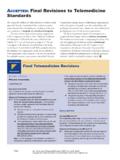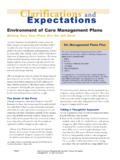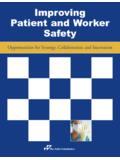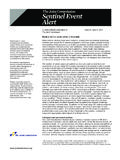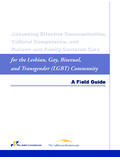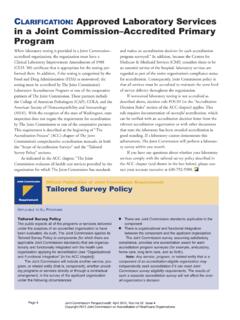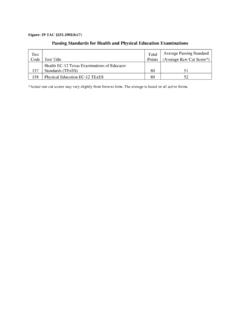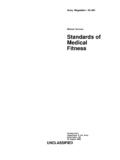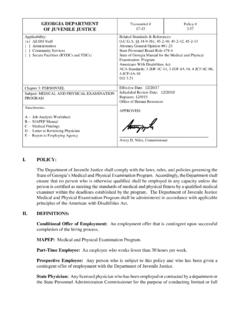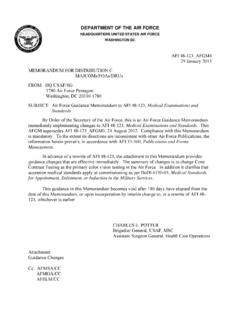Transcription of Standards for Physical Examinations - Joint Commission
1 Behavioral Health Care Accreditation ProgramStandards for Physical of Performance for organizations providing care, treatment, or services in non-24 hour settings: The organization implements a written process requiring a Physical health screening to determine the individual's need for a medical history and Physical 1: This standard does not apply to foster care and therapeutic foster care. (Refer to , EP 1 for more information)Note 2: This standard does not apply to organizations that provide Physical Examinations to all individuals served as a matter of policy or to comply with law and organizations providing care, treatment, or services in non-24 hour settings: The organization has a written Physical health screening process to determine whether an individual served is in need of a medical history and Physical examination that is based on the population(s) served and, at a minimum, includes the following:- Data to be collected- Time frame for completion of the screening- Screening triggers that indicate the need for a medical history and Physical organizations providing care, treatment, or services in non-24 hour settings.
2 The organization has a practitioner qualified by the scope of his or her license participate in developing the data to be collected and the Physical health screening organizations providing care, treatment, or services in non-24 hour settings: The organization determines whether the date of the individual s most recent Physical examination exceeds one year. If the date exceeds one year, a medical history and Physical examination is organizations providing care, treatment, or services in non-24 hour settings: The organization implements its written 1 of 4 Report Generated by DSSMT hursday, Jul 21 2011 Pre-Publication Version 2011 The Joint CommissionBehavioral Health Care Care Accreditation of Performance for organizations providing residential care: The organization screens all individuals served to determine the individual s need for a medical history and Physical 1: This standard does not apply to foster care, therapeutic foster care, and emergency shelters.
3 (Refer to , EP 1 for more information)Note 2: This standard does not apply to organizations that provide Physical Examinations to all individuals served as a matter of policy or to comply with law and 3: "Residential care" includes residential settings, group home settings, and 24-hour therapeutic organizations providing residential care: The organization has a written screening process to determine whether an individual served is in need of a medical history and Physical examination that is based on the population(s) served and, at a minimum, includes the following:- Data to be collected- Time frame for completion of the screening- Screening triggers that indicate the need for a medical history and Physical organizations providing residential care: A practitioner qualified by the scope of his or her license approves the organization s screening organizations providing residential care: Individuals for whom a Physical examination conducted by a practitioner qualified by the scope of his or her license is indicated are either examined by the organization or referred to an outside source within 30 calendar days after admission, or sooner if warranted by the individual s Physical health needs, and in accordance with law and organizations providing residential care: When a Physical examination has been completed by a practitioner qualified by the scope of his or her license within the 12 months prior to the individual s admission and the organization accepts this in lieu of conducting another Physical examination , the organization notes any changes to the individual s Physical health condition and documents it in the individual s clinical/case record.
4 If any changes(s) to the individual s Physical health condition prompts any of the screening process triggers, a new medical history and Physical examination is organizations providing residential care: The organization determines whether the date of the individual s most recent Physical examination exceeds one year. If the date exceeds one year, a medical history and Physical examination is organizations providing residential care: The organization implements its written 2 of 4 Report Generated by DSSMT hursday, Jul 21 2011 Pre-Publication Version 2011 The Joint CommissionBehavioral Health Care Care Accreditation of Performance for organization completes a Physical health assessment, including a medical history and Physical : This standard does not apply to foster care and therapeutic foster care. (Refer to , EP 1 for more information)For inpatient crisis stabilization: A Physical health examination is performed by a licensed independent practitioner within 24 hours of 1: Some Physical health needs require completion of a Physical health assessment within a shorter time 2: If a medical history and Physical examination has been completed by a licensed independent practitioner within 30 days before admission, a legible copy of this report may be used in the clinical/case record as the Physical health assessment.
5 Changes to the condition of the individual served since completion of the history and Physical are recorded at the time of organizations that conduct outdoor/wilderness experiences: A Physical health examination is performed by a licensed independent practitioner within 30 days prior to participating in an outdoor/wilderness 1: Some Physical health needs require completion of a Physical health assessment within a shorter time 2: If a medical history and Physical examination has been completed by a licensed independent practitioner within 30 days before participating in an outdoor/wilderness experience, a legible copy of this report may be used in the clinical/case record as the Physical health assessment. Changes to the condition of the individual served since completion of the history and Physical are recorded at the time of admission to the opioid treatment programs: The program completes a medical evaluation within 14 days after treatment is opioid treatment programs: The Physical assessment includes an examination of the following:- Clinical signs of addiction, such as old and fresh needle marks, constricted or dilated pupils, and/or an eroded or perforated nasal septum- Observable and reported presence of withdrawal signs and symptoms, such as yawning, rhinorrhea, lacrimation, chills, restlessness, irritability, perspiration, piloerection, nausea, and diarrhea Note: On-site point of collection devices may be useful in screening a patient s current physiological opioid treatment programs: The program documents the patient s medical and family history to determine current chronic or acute medical conditions, such as diabetes; renal diseases; hepatitis A, B, C, and D.
6 HIV exposure; tuberculosis; sexually transmitted diseases; other infectious diseases; sickle-cell trait or anemia; pregnancy (including past history of pregnancy and current involvement in prenatal care); and chronic cardiopulmonary opioid treatment programs: Based on the patient s history and Physical examination , the program evaluates the possibility of various conditions (such as infectious disease, liver or pulmonary conditions, cardiac abnormalities, psychiatric problems, dermatologic sequelae of addiction, and concurrent surgical problems). Note: This may be accomplished within the program itself, or by referring the patient to a cooperating agency or a consultant opioid treatment programs: Patients who test positive for viral hepatitis receive a referral for further evaluation and treatment, if 3 of 4 Report Generated by DSSMT hursday, Jul 21 2011 Pre-Publication Version 2011 The Joint CommissionBehavioral Health Care Care Accreditation ProgramFor opioid treatment programs: The program immunizes the patient, or refers the patient for immunization, against hepatitis A and B if not already immune, and against other viral hepatitis strains as those vaccines become 4 of 4 Report Generated by DSSMT hursday, Jul 21 2011 Pre-Publication Version 2011 The Joint Commissio

